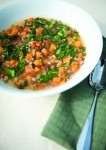 by Ellie Topp, Professional Home Economist
by Ellie Topp, Professional Home Economist
‘Eat your vegetables,’ has been consistent advice echoed by mothers for generations.
Significant advances in nutritional science over the past two decades have confirmed that mother was ‘right on’ with sound nutritional advice by emphasizing vegetables. In fact, vegetables and fruit have been found to be so important for our overall health that they constitute the largest arc on Canada’s Food Guide rainbow. According to Health Canada, eating a variety of vegetables and fruits regularly may help reduce the risk of some types of cancer and may also lower the risk for heart disease.
‘Reduce your salt intake’ is current medical advice making reverberations similar to mom’s veggie guidance.
But over the years, salt (or more specifically sodium, the major component of salt) has had a mixed message. It has been used as a preservative and flavour enhancer for generations. Today, as more of our food is prepared outside the home, salt has been steadily increasing in our diet. For some people this is not a problem, but for others who are especially salt sensitive and who have hypertension, it can be a significant factor.
The salt industry has long maintained that there is no hard evidence that salt intake is harmful. With increasing recognition of the link of sodium to hypertension, research is continuing into the impact of salt in our diet. Since 1995, scientists from Canada and the United States have been collaborating in a review of the scientific information on sodium, but the evidence has not been found to be clear-cut.
Vegetables add significant nutritional benefits to meals. In addition, the great variety they offer adds fantastic flavours which can help to limit the amount of sodium required to make food tasty. This is the approach taken in the cookbook, Fresh and Healthy Cooking for Two – Easy Meals for Everyday Life (Formac 2011) by Ellie Topp and Marilyn Booth.
The book offers recipes with special focus on the importance of vegetables, fruits and whole grains. Marilyn (my co-author) and I monitored the salt in each recipe to ensure that the amount of sodium was kept ‘in-check’. Our objective was to restrict the number of milligrams of sodium to less than the number of calories provided in each recipe.
Onions and garlic are well known for their flavour-boosting ability. But other veggies such as sweet and hot peppers, fennel and parsnips along with lesser known members of the broccoli family – bok choy, broccoflower, collards, kale and rapini (aka broccoli rabe) – make savoury additions to dishes where salt is limited.
A tasty example of using vegetables to enhance flavour is this soup featuring sweet potato, tomatoes and kale. Kale can be somewhat pungent, but added to a soup, it develops a soft sweetness that combines wonderfully with the flavour of sweet potato. Sodium is limited by choosing ‘no-salt added broth’ which is becoming more readily available. Each serving of this soup has 285 calories with 114 mg of sodium. Look to increase your vegetable intake by choosing veggies that are less familiar to you and slicing and dicing a variety into whatever you are cooking to boost flavour and reduce the need for salt.
SOUP WITH LENTILS, FRESH HERBS AND KALE
1 tbsp olive oil 15 mL
1 clove garlic, minced 1
1 onion, diced 1
1 small sweet potato, peeled and diced 1
1/2 cup dried brown lentils, rinsed 125 mL
1/3 cup brown rice 75 mL
2 large tomatoes, peeled and diced, about 2 cups (500 mL) 2
4 cups low sodium chicken broth 1 L
1 1/2 tsp chopped fresh oregano or 1/2 tsp (2 mL) dried 7 mL
1 1/2 tsp chopped fresh basil or 1/2 tsp (2 mL) dried 7 mL
2 cups chopped kale, fibrous stems removed 500 mL
Salt and ground black pepper
1. In a large saucepan, heat oil over medium heat. Add garlic, onion and sweet potato; cook for 8 minutes, stirring frequently or until soft.
2. Add lentils, rice, tomatoes, broth, oregano and basil. Bring to a boil, reduce heat, cover and simmer for 1 hour or until lentils are tender.
3. Stir in kale, return to a boil and simmer for 5 minutes or until kale is tender. Add salt and pepper to taste.
Makes 4 servings, 1 3/4 cup (425 mL) each
Recipe taken from Fresh and Healthy Cooking for Two – Easy Meals for Everyday Life, by Ellie Topp and Marilyn Booth (Formac 2011)
For more tips on reducing the amount of sodium in your diet check out: https://www.heartandstroke.ca/healthy-living/healthy-eating/reduce-salt
Ellie Topp is an Ottawa-based Professional Home Economist and certified culinary professional. She is co-author of several cookbooks including The Complete Book of Year-Round Small Batch Preserving and Savoury Wisdom: Delicious Recipes for Two.
Ontario Home Economics Association (OHEA) a self-regulated body of Professional Home Economists promotes high professional standards among its members so that they may assist families and individuals to achieve and maintain a desirable quality of life.
For further information, please contact: Ontario Home Economics Association https://www.ohea.on.ca






